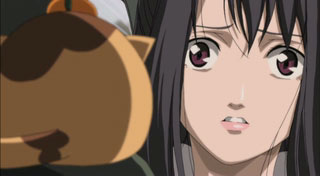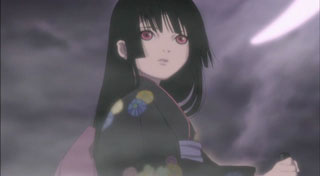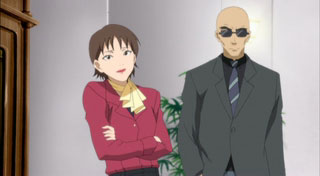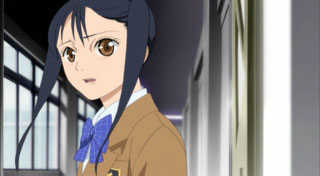 Logo handmade by Bannister
Column by Scott Green
Logo handmade by Bannister
Column by Scott Green
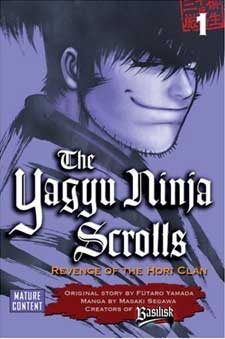
Manga Spotlight: Yagyu Ninja Scrolls By Masaki Segawa Released by Del Rey
The Yagyu Ninja Scrolls is another goldmine for genre fans in the tradition of Basilisk. Working from a novel by Futaro Yamada, the striking images of the digitally inked manga give cartoonish life to an action spectacle that borrows heavily from the toybox of history. In the space around these legends, Segawa adapts the exploitation blood bath constructed by Yamada. Yagyu Ninja Scrolls might be a few degrees less predictable than the Romeo and Juliet Basilisk, but again, the general idea is to have two conniving, murderous forces at each other's throats. The format offers little in the way of sensitively, but the depth of lore, and the glee with which it plays in the sandbox of history and popular legend, demonstrate the intention of offering a full force attack on ninja fiction. The idea seems to be to outdo other comparable action conceits. If other stories dedicate themselves to a noteworthy ninja competing with others of his kind, Yagyu Ninja Scrolls calls in the age's most famous for an explicitly lethal death match. Basilisk, aka the Kouga Ninja Scrolls (or Shinobi: Heart Under Blade if you count the live action) was initiated by Tokugawa Ieyasu, the founder of the Tokugawa shogunate instigating the re-commencement of the feud between the Kouga and Iga ninja clans in a competition that would decided his successor. Tokugawa's meeting with the heads of the Kouga and Iga villages, which are reputed to have been historical ninja havens, included Hattori Hanzo, and Yagyu Munenori, and if you were playing chambara bingo, it was time to shout out your victory. By virtue of the involvement of these historical/semi-historical players, The Yagyu Ninja Scroll or Yagyu Ninpocho, as Basilisk author Futaro Yamada's novel was known, could be thought of as a tangential sequel to Basilisk. This time, Tokugawa Iyemitsu (or Iemitsu), grandson of Tokugawa Ieyasu is the shogun facilitating a new blood fued between a a subject clan and the warriors of a regional lord. Samurai fiction fans probably recgnoze the significance of a title like "The Yagyu Ninja Scrolls." The swordsmen of the Yagyu have long been a chief mainstay of the genre. Koike appropriated them as the villains of Lone Wolf and Cub. Eiji Yoshikawa incorporated them into his novelization of the life story of Musashi Miyamoto, which in turn became Takehiko Inoue's award winning manga Vagabond. Amoung the swordsmen of this reknowned clan, the paragon of its noteriety is the historical/semi-historical figure Jyubei Yagyu. Jyubei Yagyu holds a lock on the popular imagination as one of the most featured samurai legends. On a factual basis, there is evidence that he served the second and third Tokugawa shoguns in their court and as a fencing instructor. In legend, he was the secret agent to the shoguns: a James Bond of the ninja world. In the modern samurai parlance, he's everywhere, from video games like Samurai Showdown and Onimusha, to anime, where he's recently been reincarnated as a teenage girl Jubei-chan the Ninja Girl. Fans should take note that Yamada would follow-up on Yagyu Ninpocho with Makai Tensho, in which Jyubei Yagyu would duel with Amakusa Shiro, of the historical Shimabara Rebellion, along with an army of the undead. Makai Tensho has been adapted into three films (four if you count the sequel), including one with Sonny Chiba as Yagyu, an anime series (released as Ninja Resurrection by ADV), and four manga. The Yagyu Ninja Scrolls is not quite the jackpot that its sequel is, but if you're a follower of samurai legends and fiction, the prospect of Jyubei Yagyu versus the Aizu spearmen still makes for a thrilling meeting of the greats. The manga opens with seven strikingly unusual warriors riding into town behind a strange procession: a trio of dogs, each leading a row of beaten, bound and gagged warriors. The men on horseback are the feared elite of the Aizu Seven Spears and their prisoner are the remnants of the Hori clan. Action then cuts to a meeting between Tokugawa Iyemitsu and his advisors to debate how to handle this potentially politically incendiary death march. The Hori clan was vassals to the sadistic, deviant Kato Shikibunodho Akinari. In response to Akinari's violation of their women, the Hori rebelled. And while, Tokugawa could express little love for Akinari, the foundation of his state rested on the dominion of lords over their vassals. Unfortunately for the politicians, the situation became dicier when the Seven Spears dragged the Hori men to the Tokeiji Temple, a monastic refuge for women, including the surviving Hori women, and Princess Sen, older sister of Tokugawa Iyemitsu and ex-wife of his political rival Toyotomi Hideyori. When all is said and done, 23 of the temple's nuns were dead, along with the 21 Hori men, leaving seven Hori women living as nuns. Incensed by the violation of the temple, Princess Sen calls for Zen priest Takuan Soho, who in turn brings Jyubei Yagyu. Young, brash, but already sporting his trademark missing eye, Jyubei Yagyu proves to be intrigued by the situation. Holding his own grudge against the Seven Spears, he agrees to train the surviving Hori women so that they can exact vengeance for the extermination nof their clan and the desecration of the Tokeiji Temple. What's interesting about The Yagyu Ninja Scrolls is that while it is another Ninja Deathmatch, it's also an exercise in asymmetric warfare. Jyubei states plainly that even if he had 100 years to train the Hori women, his pupils would still not be able to outmatch their foes. In terms of skill, their adversaries are a moving target with a monumental head start. The Aizu Spears have already endured a lifetime of harsh training to develop skills that they are continuing to improve. Instead, Jyubei declares that there training will focus on the art of war "the Sun Tzu school, the Kung Ming School, Kusunokii Koshu, Sanada..." On one side, you have a collection of freakish martial artists matching the depths of Kawajiri anime or Shaw Brothers movie (a one armed swordsman, a small man who wields a sickle and chain, a doughy man with a whip, ect). On the other side, you have a group of women forced to become nuns, then forced to ensnare the men who wronged them. This seems like a vicious varient of the classic brains versus braun; a to-the-death competition of deceit and violence. As such it seems reasonable to expect nastiness more than anything else, but if that's what your looking for in your action media, The Yagyu Ninja Scrolls is probably an ideal choice. This direction also makes Kazuo Koike's Lady Snowblood look like a feminist work. This isn’t to say that the manga is as violently misogynous as some. Even though the manga reads like it is unrestrained, the worst of the crimes happen out of view. For example, Akinari's torture chamber is shown, but its use isn't. Yet, the Hori women are reduced to weeping. Page after page features these characters covered in tears, highlighted by running noses. Not only is Jyubei Yagyu patronizing, he is quick to inform the Hori that in addition to sacrificing their lives, the effort will require that they sacrifice their virtue. If you were thrilled by the action of Basilisk, The Yagyu Ninja Scroll is the perfect follow-up. If you were ambivalent to Basilisk's love story, this manga looks like it could be an improvement. For fans of buckets of blood ninja/samurai fiction, this one has the right qualities. It has the personalities, the historic ties, the wildly exaggerated abilities and strangeness. If anything warrants the evocation of "Ninja Scroll" and what that movie has come to represent, it's Yamada based works like this.
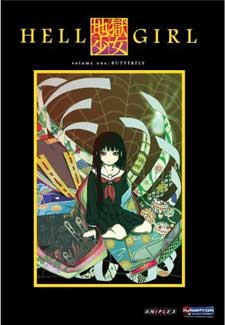
Anime Spotlight: Hell Girl Volume 1 Released by FUNimation
Anime horror anthologies have been able to rely on the disquieting notion of a supernatural world that is cruelly indifferent to humanity. The idea of a creature with greater control over circumstances, who can lead a person into suffering and be unphased about it is a chilling premise. It's as if there was a world of Satanic accusers with no balancing advocates. Hell Girl leverages the horror of that precarious hold on the material world, but at the same time, the act of ritualistically sending someone to eternal damnation is presented as a strong remedy. In Hell Girl (Jigoku Shojo), troubled individuals follow an urban legend to a web site that only appears after midnight. There, they can enter the name of the person who has made there their existence unlivable. The individual is then given the chance to enter into a pack with Ai Enma (or Ai Emma has the subtitles suggest, since "Enma" is the Japanese name for the Buddhist ruler of the underworld, Yama, the former makes more sense). The afflicted summoner can rely on Ai Enma to banish their tormenter to Hell, but as a consequence, upon death, the summoner will likewise suffer eternal punishment. If being able to write away a enemies makes Hell Girl sound like "Death Note for fifteen year olds", it’s because it is. Then again, Death Note is pretty much "Death Note for 15 year olds". Like Death Note, Hell Girl's world of unforgiving punishment has caught the attention of its audience. Hell Girl doesn't have Death Note's mind games, but the empowerment aspect of Death Note has a parallel attraction in Hell Girl. Internationally, news services have latched onto the proliferation of teachers who have become agitated about student carrying their own "Death Note" notepads. Hell Girl is not about to spawn a copycat website, but attraction to that power has a parallel in Hell Girl, which was a notably popular series in Japan. The 26 episode Studio Deen anime was popular enough to warrant a second season, a live action adaptation and a manga.The first five episodes of Hell Girl do suggest hints that Ai Enma is a character and not just a device. Maybe the series will use this \ if it later adopts focused drama, but through the first five episodes, the intent is directed toward the ritualistic destruction of the sadists who make life unbearable. In each story, a young protagonist is punished for coming into contact with the villain. There life is brought to near-ruin. Finally, their hand is forced. They enter into the agreement with Ai Enma. In the climax, Ai, along with her assistants perform a brief morality play for the villain, before Ai boats the former tormenter off to hell. The once-victim is left with a repaired, happy life, but a mark on their chest to remind them of their own post-mortem fate. Hell Girl is good for what it is and regrettable for what it isn't. What it does do well is present punishment in a tidy package. Bad people are brought down, hard. What happens to the people who call up this dire fate? Their blow back is definitively scheduled for the end of their lives. The punishment and the implications... settled in one stroke. The act of ritual retribution becomes a spectacle. Music by Yasuharu Takanashi sets a haunting backdrop. Ai's accomplices take their places. Studio Deen draws the shades for an eerie half-light. And the stage is set for skeletons and specters to bring the bully to their knees. Director Takahiro Omori cuts to the point with these sequences. They are macabre without being upsetting; otherworldly without using the scenes as a platform for demonstrating animation technique. The agenda and the metaphors are obvious: holding the villain down, stripping them of their position and attributes, making them the victim. But, that direct, obvious approach fits into the ritual nature of these stories. By the end, everything is properly in order. The potential disappointment in Hell Girl is that while the concept could have been, the execution is not a lesson in metaphysical economics. There is an implicit question that comes with the show's high concept: should one sacrifice eternal salvation for an immediate solution to an acute threat? Ai redresses various problems: future prospects being cut off mortal danger, family ruin... However, nothing is ever substantially weighed. Not cost versus benefit, nor moral justification. It's not a complex look at what causes people to react. It isn't Sky High, Tsutomu Takahashi's story of the gatekeeper to the afterlife, who gives wronged souls the choice to ascend to heaven for reincarnation, remain in the mortal world as a ghost or curse another living person and in doing so, condemn themselves to hell. In the case of Hell Girl, the moral ambiguity ends at the protagonist flashing forward to their own infernal future. So far, life after the decision has not been a concern. Nor has the fact that Ai Enma is effectively taking advantage people at their most vulnerable and doubly victimizing her summoner. Not that the series are a fair comparison, Sky High is approaching a different audience with different expectations, but if you are looking for moral complexity in Hell Girl, the first volume will not satisfy your desire. 
The exercise is defined by roles arranged in such a way as to vent frustrations through the elaborate punishment of the wrong-doer. Hell Girl takes the mean or unfeeling elements of life and turns them into situations where one is arguably justified in sacrificing future happiness to end the problem. The victims are tossed about by the capricious world. The villains are evil people who ruin lives on a whim, for greed, lust, or shallow benefits. These blackmailers and stalkers are bullies exaggerated to sociopathic extremes. The first of the volumes five episodes features a girl who is quiet, but does things right, whose life is derailed when she is steamrolled by a bully. She's framed for losing a sizable sum of funds raised by the class. After being slapped, forced to steal from her parents and photographed in compromising situations that explicitly endanger her high school prospects, Ai Enma is called in. The second features a girl tormented by a stalker. Though her father tries to protect her, he, and the police prove to be impotent to stop the harassment. For this girl, fear has stripped the individual of all of her humanity, reducing her to screamed reactions and "why" questioning. Just when Hell Girl started to look like a girl in distress melodrama written by men, the anime produces a male victim and with that factored in the series demonstrates that it isn't about girls in danger, its about victimization and redress. In constructing these harrowing situations, the anime asks to be taken at face value, with an emotional response. A rationale is always presented, but reading into the actions of the victims or villains detracts from the illusion. The anime seems to be exaggerating further as it goes along. The first case is an after school special example of extreme bullying. Then, the stalker case plays out like a scenario from crime fiction. In the story of the male protagonist, the villain’s ploy plays out with literally incredible perfection. There's Little Nell mirth to the fourth story, in which an orphan girl's dog dies from the neglect of a veterinarian who'd rather spend his time golfing with local politicians. Both the third and fourth stories emphasize that these characters are scripted into a path. Both try to solve the problem without Ai, and in both cases the effort is immediately cut off as futile. In episode five, the dynamic almost gets interesting, but again, it's a script driven situation. In that case, the ploys and the ploys within ploys never feel grounded in reality. Hell Girl is not the most ambitious horror anime. Nor does it have the fervor of enthusiastic horror manga. But, it does allow the viewer to feel a bit of anger at the actions of the villains and a bit of a release when these heels are punished. This cycle is presented well enough that as a ritual; the familiar pattern becomes a hook for the series. It's not something to become enthralled to, but it does invite the habit to start looking forward to the next episode. 
